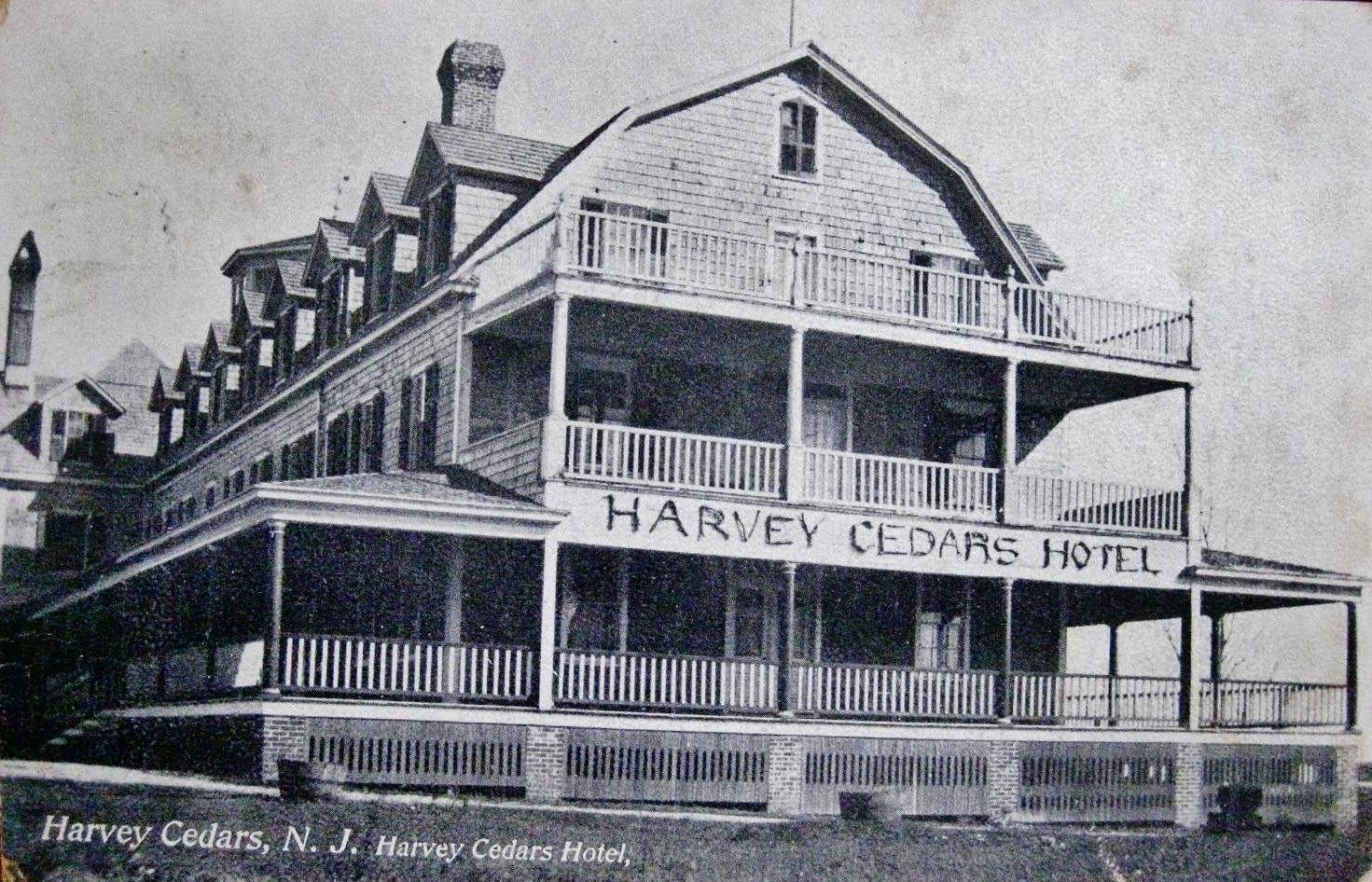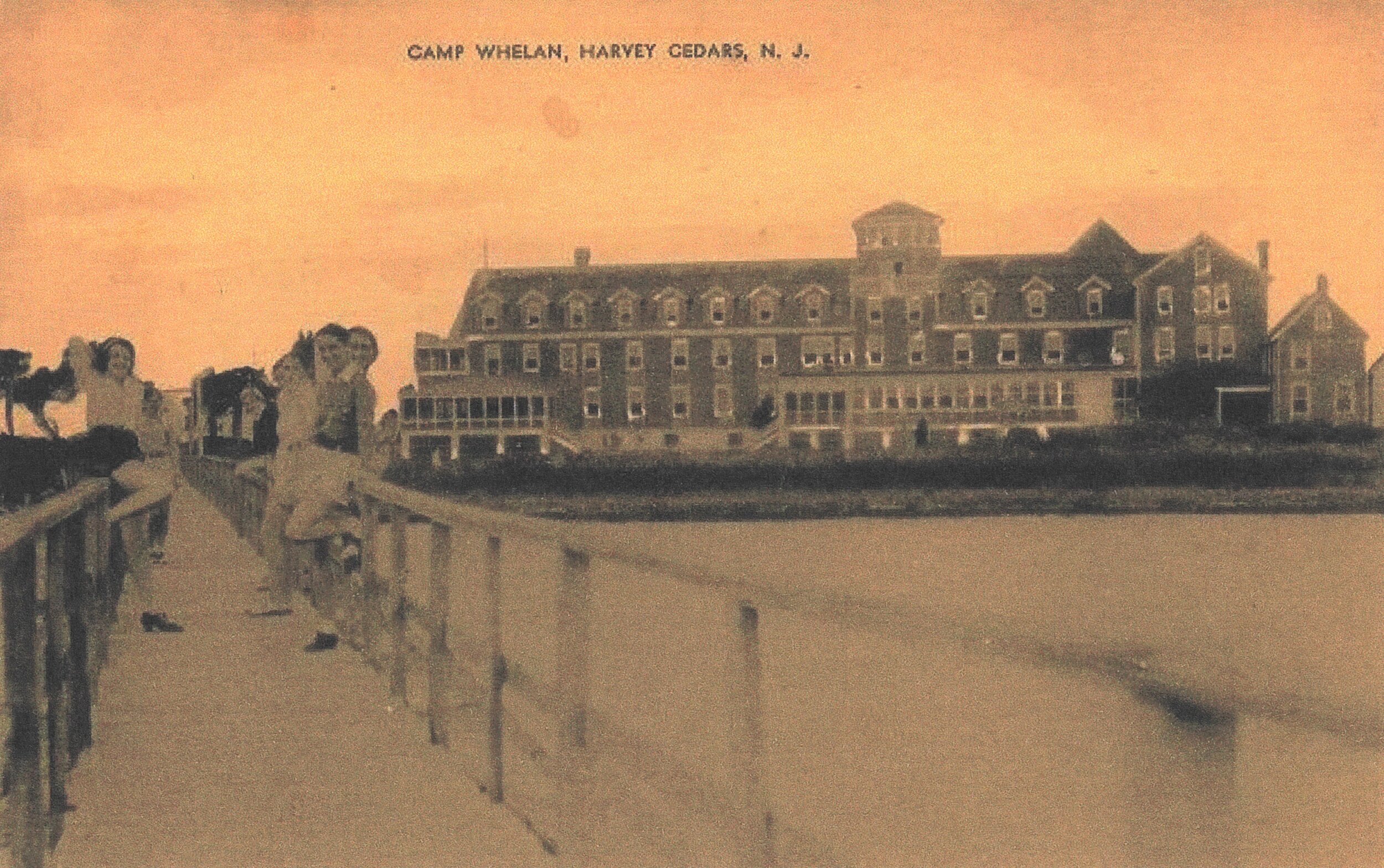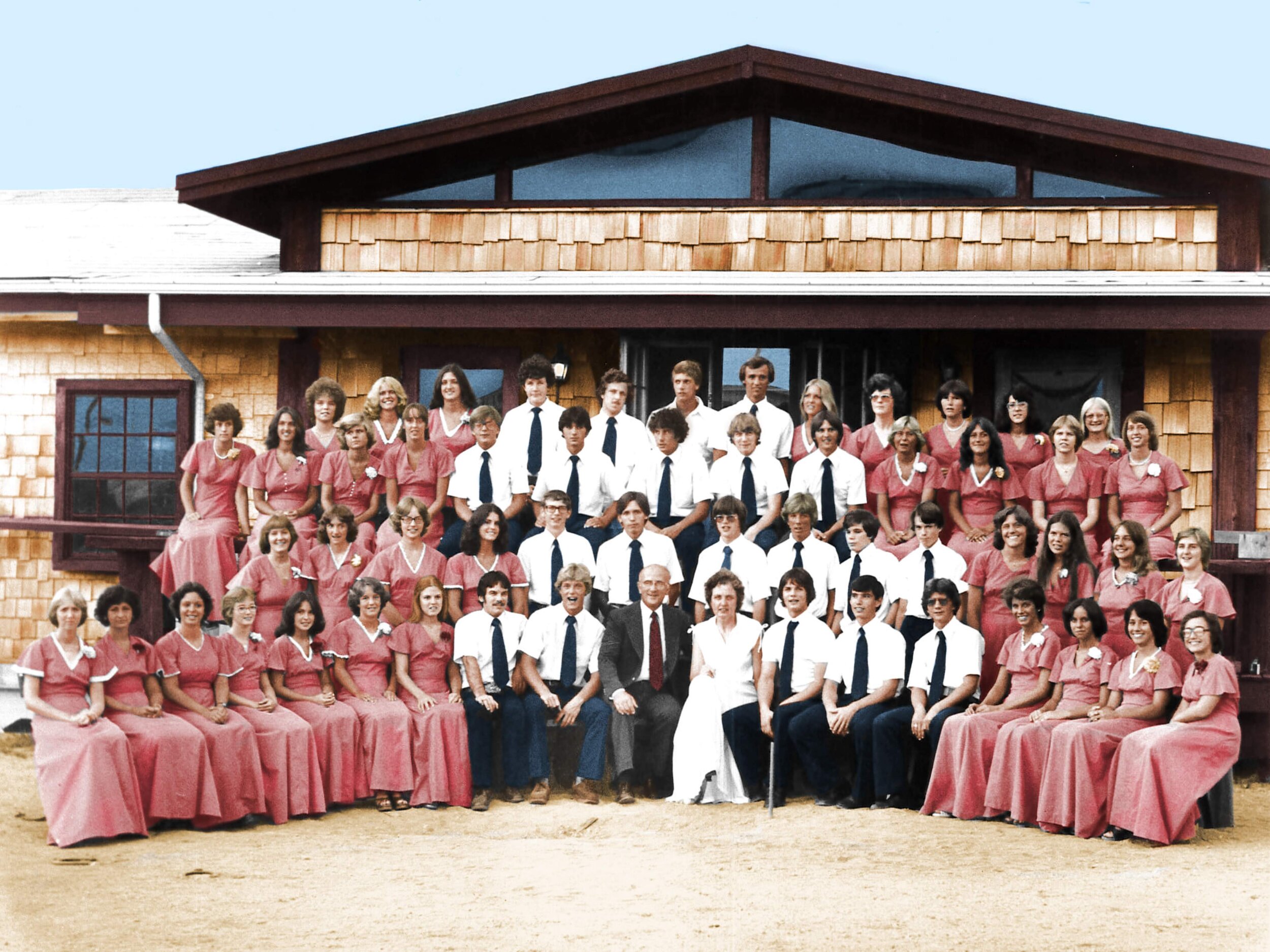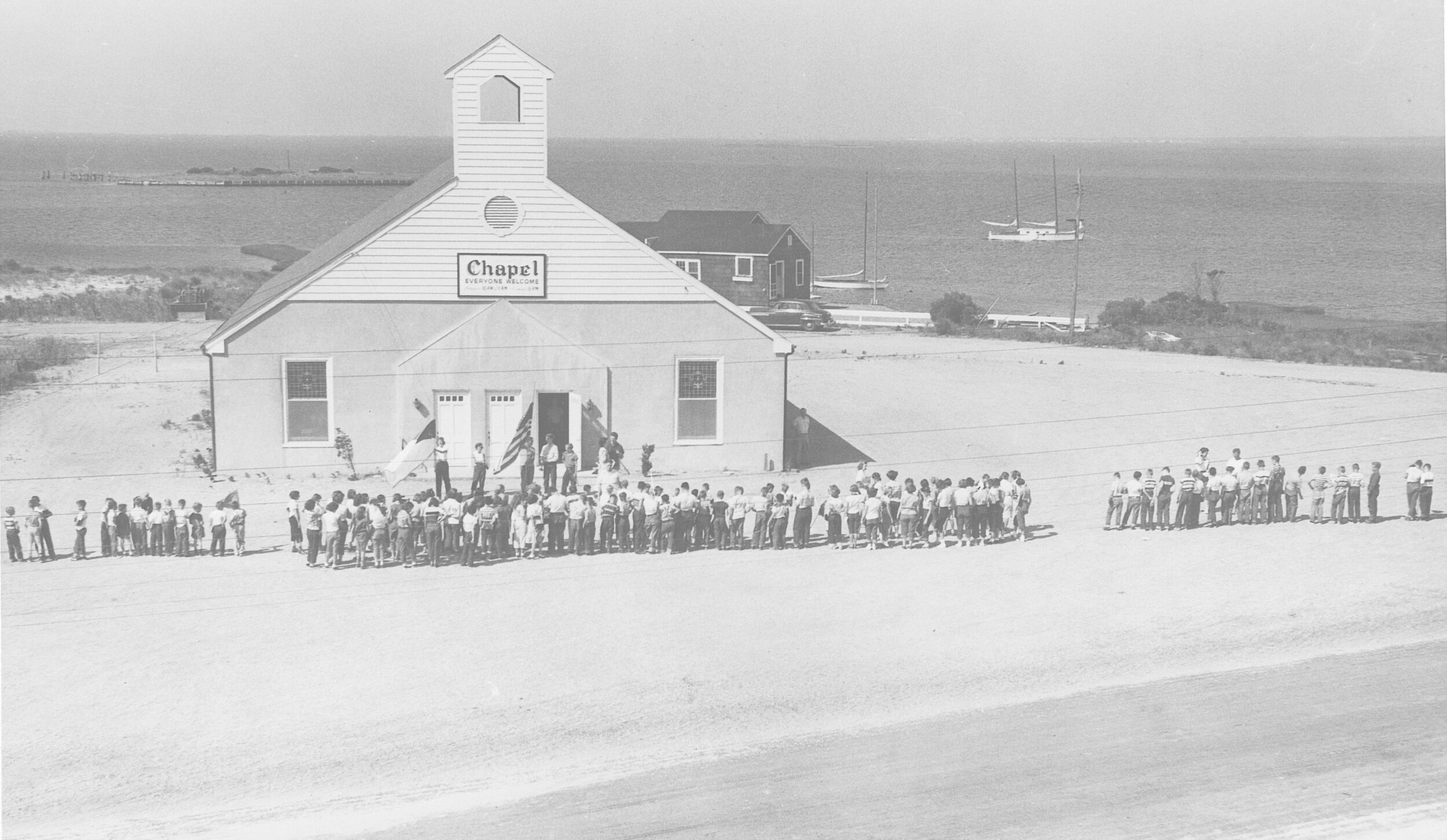History
Since Harvey Cedars Bible Conference opened its doors in 1941, God has used it to change countless people’s lives. While it has expanded and developed throughout the years, it has remained committed to its mission to be a place where people hear the gospel and become closer to Christ.
This historical account includes details about the 19th-century Victorian Hotel that was restored and transformed into the conference center.
“God takes people who are broken and run down, restores them, and uses them for his honor and glory. The old Harvey Cedars Hotel can tell the same story.”

1837-1865
History of the Harvey Cedars Hotel
Around 1837, a farmer named Sylvanus Cox built a house [1] on an island in an area called Harvest Quarters. This small island was good for gardening and livestock, and the house would become the first section of the Harvey Cedars Hotel. Cox also built a bridge across the creek. [2]
In 1841, Captain Samuel Perrine of Barnegat purchased and added to the house, turning it into the “Connahassett House,” which served as a lodge primarily for fishermen and duck hunters who came ashore to ride out storms and replenish supplies. There were plenty of large hotels on Long Beach Island, but smaller ones like Perrine’s attracted a New York crowd of wealthy men who savored the rugged experience, enjoying seafood, waterfowl, liquor, and gunning.
[1] As seen in this section’s photo, the original structure included the T-shaped section from the present main lounge (half of which was originally a porch) to the present entrance sign. According to former director Al Oldham, the oldest parts used mortise-and-tenon construction with 3x8" rough-hewn joists, and original windows remained inside first floor walls until renovations in 2004.
[2] The creek was filled in during the 1960s, making the island a peninsula as it is today.

1865-1886
Harvey Cedars Hotel: Samuel Perrine & Isaac Jennings
The most notable attraction of Perrine’s hotel was its ballroom, a building on the south side where dancers enjoyed his fiddling. He was an entertaining host and was also in charge of the Harvey Cedars unit of the US Life Saving Service. Captain Perrine was the grandfather of J.H. Perrine, builder of Barnegat Bay sneakboxes and other boats, who made over 3,600 craft in his yards over 55 years.
Perrine’s hotel became famous along the shore. Sailing parties from other hotels came on summer evenings for lively square dances and reels. The sound of fiddles and chanting filled the air far out on the water. Before the dock was added, boats might hit low tide and men would get out and carry their women up to the dance hall.
Around 1865-1870, after being a Civil War quartermaster, John Warner Kinsey began running the hotel, which became known as “Kinsey’s.” According to census records, he continued as its keeper until at least June 1880. [1]
Captain Isaac Jennings, the first mayor of Harvey Cedars, was in charge of the Harvey Cedars Hotel by 1881, sometime after Perrine passed away. It was nearly self-sufficient with fruit trees, gardens, animals, and an abundance of seafood from local waters.
During this time, additional rooms and a porch were added to the south end of the hotel. Jennings’ wife Mary made the kitchen meet other island hotels’ high standards, featuring a long bay-facing bar and an extensive farm and garden.
By 1886, Jennings had passed away and Harvey Cedars Beach Company owned the hotel and 200 acres of land. The Tuckerton Railroad's expansion onto Long Beach Island generated new hope for the hotel—the rail line ran almost the entire length of the island.
[1] One source claims that the Harvey Cedars Hotel was destroyed in a fire and rebuilt in 1880. In decades of repairs, there have been no ashes or signs of a fire found at the foundation. The present building indicates alterations from the pre-1880 structure, including floorboard changes, plaster under the building, and evidence in first-floor walls that it once had doors to an outside porch. In addition, a Springfield Gas Machine, dated August 17, 1868, from the basement, is on display in the main entrance today.

1886-1914
Harvey Cedars Hotel: Billy Thompson and major expansions
From 1886 to at least 1907, Billy Thompson, known as “Duke of Gloucester,” managed the Harvey Cedars Hotel and oversaw a massive expansion and renovation, giving the hotel its present external appearance.
The building was raised, creating a crawl space. The third floor [1], gambrel roof, dormers, large porches, water tower (now bathrooms and office space), and additional rooms on the bay side and north end were added, and cedar shingles replaced the white siding.
Gas lamps lit various types of rooms. The walls and ceilings of the main dining room (now the main lounge) were covered with fire-resistant decorative tin, most of which remains today [2]. The most distinctive addition was the octagonal central tower (now the Prayer Tower, dedicated in memory of Dorothy Krauss in 1948), an architectural feature popular in seashore hotels. Three fireplaces added to the first floor featured engraved logos indicating that these renovations concluded in 1903.
A small two-story building was also placed on the front side of the hotel. This “Historic Boys’ Dorm” has been used as a laundry room and a staff housing unit over the years.
The Harvey Cedars Hotel’s rates were as low as $2 per day. A surviving 1907 reservation receipt claims it was the “best gunning and fishing resort on New Jersey Coast.” With its more sophisticated look, it competed for the recreational trade that Thompson hoped would reach the island by train. It is in folklore that Grover Cleveland visited the hotel. As the town lost tourist attraction to the island’s developing south end, the hotel became a large “white elephant” that Thompson sold with all its furniture, rugs, and silverware.
By May 11, 1912, Harvey Cedars Beach Company owned the hotel again, but went into bankruptcy, and the property was sold to Walter Pincus of Philadelphia for $1,000. In 1914, Pincus sold most of the property to Daniel B. Frazier Company.
[1] Some believe the original second floor and roof were raised to become the third floor, and that the present second floor was added underneath. Floorboards indicate that the present third floor was once an attic.
[2] The Canteen and offices have drop ceilings today, but the tin underneath remains. Patterns in the main lounge include locations where gas light fixtures once were. They have been replaced with electric lighting. The main lounge’s front wall and windows were replaced during repairs in 2004.

1921-1935
Harvey Cedars Hotel: YWCA Camp Whelen
During World War I and the industrialization of America, thousands of young farm people were moving to cities. As hundreds of camps and conferences sprung up across the country, the Harvey Cedars Hotel became a vacation spot for working city girls.
In 1921, the Young Women’s Christian Association of Philadelphia purchased the hotel for $35,000. It became a summer camp called Camp Whelen [1], where hundreds of girls and counselors made memories studying biblical principles. The camp welcomed guest speakers and its dining room featured a piano that made shows popular. Many women went on to successful leadership in communities, churches, schools, businesses, and professions. In 1983, a group of Camp Whelen staff held a reunion at HCBC.
Camp Whelen closed in 1935 due to declining attendance and a lack of funds, leaving the hotel neglected for the next six years. In 1939, Miss Mabel Bayard of Philadelphia purchased the hotel, but it remained unused.
[1] Postcards and other media use a variety of spellings including “Whelan” and “Wellen.” Most official documents use “Whelen.”

1941
Harvey Cedars Bible Presbyterian Conference opens
By 1941, during the nation’s Great Depression, waterfront lots cost $75, the railroad to the island was gone, and most of the 14 great Victorian hotels on Long Beach Island had been destroyed or abandoned.
Reverend John W. "Jack” Murray was born on the west coast, but went to Wheaton College when revival swept its campus between 1935 and 1936. He spent the rest of his life in evangelism.
At 27 years old, Murray was an associate pastor of a large Presbyterian church in Chester, PA, and the National Director of the Summer Bible School Movement (later AWANA). He developed a 12-year, five-week, five-hour-per-day children’s educational program, and wanted a place to reward graduates with two-week vacations in August. He conducted summer conferences in PA state parks, but later sought to establish a permanent center.
In spring 1941, Jack’s friend Bill Ritchie showed him the run-down Harvey Cedars Hotel from the water while they were fishing on the beautiful, windswept Long Beach Island. Intrigued, they entered and found the entrance filled with feathers. Jack Murray had the vision to see its potential and decided that it would make an ideal conference center once restored.
Jack and Bill discovered that Mabel Bayard held the title and went to her Germantown home to request donating the property for their cause. She countered by asking for an offer, to which they replied that it would take all of their money to get the building to usable condition. Bayard was a hard bargainer and asked the most they could give. The men went into her foyer and prayed, letting God set the price. They returned with an offer of $7,000. She accepted, under the condition that they paid in cash within a month. A staggering sum for Depression days, Murray and Ritchie trusted God to raise it. They lacked money, but they had faith. They did their part by approaching people to ask for help, and gathered the money within the required time.
It took an incredible amount of work to restore the old hotel, but the Harvey Cedars Bible Presbyterian Conference was able to open by the end of the summer. After an afternoon worship service in the hotel’s south chapel, meetings started with great expectation on Friday, August 1, 1941. A dedication service took place that Sunday.

1941-1949
Jack & Eleanor Murray and HCBC’s early days
Jack met his wife, Eleanor, while studying at Wheaton College. Over the summer, they worked for her father, George T. Stephens, who was a leading national evangelist at the time, and they traveled for evangelistic ministry on weekends. A great revival on campus led them to commit to a life of evangelism and to each other.
As the owner of the Bible Conference, Jack was an outstanding preacher and evangelist who joyfully led hundreds yearly to faith in Jesus. He was a hard worker who would leave at 5 AM to visit farms and shops 50 miles away to buy food for guests as rationing was pervasive. Carpentry, painting, and cutting grass were not beneath his dignity.
Eleanor was a devoted wife, wonderful mother, and fantastic pianist who played for congregational singing. She trained the staff choir and did much of the cooking for many summers. She also wrote hundreds of choruses and hymns.
The Bible Conference’s early days were difficult and discouraging. Sugar, meat, gas, and construction materials were rationed. German U-boats sank oil tankers just off the island, and beaches were smothered with oil. A 1944 hurricane devastated Long Beach Island.
At the same time, American churches were struggling theologically among the political events and philosophies that were radically changing western culture. Bible conferences played a significant role in the country’s history by seeking to get back to the basics in a natural setting, away from the formal and ritualistic. Like other conferences, Harvey Cedars hoped to call the church back to the Bible and the historic Christian faith.
The conference operated in the summer with worship services conducted every morning and evening. The rest of the year, the Murrays traveled in greatly successful week-long evangelistic crusades. Through them, and Jack’s daily radio programs, many came to faith in Christ and many converts and friends were attracted to the conference’s family weeks. Nationally known figures such as Francis Schaeffer, Vernon Grounds, and Jack Wyrtzen frequently spoke at Harvey Cedars.
In 1946, work started on the present dining room as attendance increased [1]. In 1947, God provided in unexpected ways as funds were raised and plans drawn for the chapel, completed in 1950. The chapel originally featured stained glass windows from the demolished Engleside Hotel dining room, which were removed in renovations in 2003.
Story of the Chapel - Rev. Jack Murray (PDF)
In 1949, the conference’s name was changed from Harvey Cedars Bible Presbyterian Conference to Harvey Cedars Bible Conference as the ministry broadened in outreach. Committed to its success, Jack and Eleanor laid a strong foundation through ten years of sacrifice and hard work. Their legacy lives on as two of their children, George Murray and Sarah Eremic, continue contributing to the ministry as speakers.
[1] The original dining room was in the space that is now the Victorian Hotel’s main lounge and would seat 150. The Canteen was originally the kitchen.

1949-1951
Al Oldham becomes director
Albert Oldham was a teenager impressed by Jack Murray's preaching. He heard Murray speak of the Bible Conference and his need for teens to serve on staff. Al volunteered in the kitchen [1] for three summers, and that decision changed his life.
One evening, in the conference’s south lounge, Pastor George Schmeiser from Philadelphia spoke on 2 Corinthians 5:14-21. He stressed Paul's logic: if Jesus left Heaven to come and love us, live for us, and die for us, we have no right to live for ourselves, but rather we should live for him. That night, Al walked forward and decided to live for Christ. He changed his plans for law school to attend Wheaton College and Faith Theological Seminary, where Jack Murray taught. Upon graduation, Jack asked 23-year-old Al to become his assistant director for the summer of 1951. Al struggled with the request, but with sincere prayer, he sensed God's direction to accept.
Jack Murray was under much pressure: he was a pastor of the vibrant Church of the Open Door in Philadelphia, spoke daily on the radio, taught twice weekly at the seminary, and managed the conference’s staff and programs. After his doctor warned him he needed rest, Jack resigned—coincidentally on the conference's 10th anniversary: August 1, 1951.
Al had no idea. To his surprise, the board chairman drove from Haddonfield and informed him that Jack resigned and was leaving the next day. He asked Al to either shut the conference down or run it until they could find a replacement for Rev. Murray. However, as Rev. Al liked to share, "They couldn't find anyone else to do the job for 44 years!"

1951-1995
Development by Al and Dorothy Oldham
Many changes came to the conference under Al Oldham's leadership. With God's providence, sacrifice, and perseverance, HCBC became debt-free as it remains today. In addition, it changed from a summer camp to a year-round retreat center.
Volunteers built a small bookstore outside the chapel with wood from houses ruined by the March storm of 1962. That bookstore was later replaced by an addition to the chapel featuring a bookstore, nursery rooms, and a dormitory in 1975. Other facility additions included the indoor pool (1989), Poolside Lodge (formerly “Driftwood Lodge,” 1965), a gymnasium (1970, now The Cedars and The Avenue), and dining room additions (1975).
Al's wife, Dorothy, continued Eleanor Murray's tradition by directing the staff choir and delighted visitors with her beautiful violin. Dorothy also sewed the staff girls' dresses. Throughout the years, all of Al and Dorothy’s children have worked at the conference.
Al resigned as director in 1995 and continued to serve on the Board for the rest of his life.

1995-2004
Jon Oldham becomes director, further development
Al Oldham's son, Jonathan, became Assistant Director of the conference in 1990 while overseeing Food Services and Maintenance. He became Executive Director in 1995 and remains so today. Jon's passion is for the conference to stay true to its original purpose: to be a place where people preach the gospel and experience life change after encounters with the living God. During this time, it gained its description as a place “where Christ finds people and changes lives.”
Jon has maintained a passion for improving the facilities to meet growing expectations and increase capacity. Jon served as general contractor for the construction of Bayview Lodge in 1994. He later oversaw an expansion to the old hotel which added conference rooms, stairs, offices, and air conditioning, and renovated its first floor in 2004. The building was officially named the Victorian Hotel as it is the last remaining one of its time on Long Beach Island.

2005-present
Continued expansion of ministries and facilities
In 2005, Jon and the Board developed long-term plans for facility upgrades and additions. In a series of campaigns, the following were achieved:
Steps of Faith (2011): The Davis Center gymnasium and activity center was built, adding recreation facilities for youth, families, and retreats.
Next Steps (2014): An addition to the north side of Bayview Lodge added ten guest rooms, an elevator, and meeting spaces. In 2016, the former 1970 gym was renovated into The Cedars (a multi-purpose meeting room) and The Avenue (a snack and game room). The Avenue features an electric fireplace with a mantel that was formerly a counter in the original bookstore. In 2018, a gazebo and gas fire pit were added by the bay.
Stepping Up (2019): The Marsh was built, adding dormitory-style accommodations for Summer Staff and year-round retreats. In 2021, volunteer groups helped renovate the Historic Boys’ Dorm to become an apartment for full-time staff.
Stepping Into the Next Generation (2024): The Cove was built, adding more guest lodging and meeting space. The Davis Center’s lounge was renovated into a café space.
The conference’s mission has remained in view through these changes. Jon Oldham continues to develop the mission to provide quality facilities with biblical programming for teenagers and families to make followers of Jesus Christ.
Continuing the tradition of family involvement, all of Jon’s children have served on staff.

Discipleship Ministries
Summer Staff and Waypoint
When HCBC began, so did its Summer Staff ministry. The high-school and college-aged staff served food, cleaned rooms, and maintained grounds for room-and-board in the early summers. Today’s staffers continue serving while growing personally and spiritually through carefully-planned programs, worship, and group studies. As a result, hundreds of those who served on staff have become pastors and missionaries.
HCBC expanded its ministry to young adults with the discipleship program Waypoint in 2019. This carefully designed program equips people to see God’s guidance in their lives through Bible study, college courses, mentorship, and practical application.
HCBC has provided many other local ministry programs throughout the years.

God takes people who are broken and run down, restores them, and uses them for his honor and glory. The old Harvey Cedars Hotel can tell the same story.
Who would ever put a business plan together where you take something past its usable life, reclaim it, and put it back into use? It makes no sense in human terms, but makes perfect sense in God's economy. He takes run-down things and makes them new again. In his eternal plan, he finds people and reclaims their lives.
Through the eyes of Jack Murray, God envisioned what LBI’s last remaining great hotel of its time could become, restored it to the best condition it has ever seen, and has been using it to change the lives of thousands who come and stay in its rooms each year.
Through Al and Jon Oldham, God has brought thousands of people of all ages to Harvey Cedars Bible Conference each year to learn, believe, and experience his love. At the oldest hotel on the island, the oldest love story in the world is retold to new generations.
“Today, Jesus Christ still searches hearts, reveals His Father’s character, changes lives, and calls disciples to follow Him as He did by the Sea of Galilee in the days of His flesh.”
If you own any historic photos either not shown here or in higher quality than shown here, you may scan and email them to activities@hcbible.org to be added to our official archive. Thank you so much!




